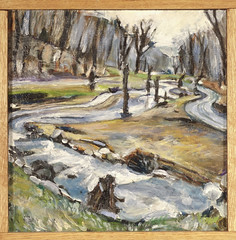Samantha says my work is all about relationships. I tend to agree.
Hawthorne (Hawthorne on Painting) speaks of painting as spots of color.
“The beauty of a picture results from the way spots of color are brought together.”
This describes the mechanics of my painting. I simply put spots of color next to other spots, while pulling out the lights and pushing the darks. The relationships between those spots fool the eye into some representational image. Click on the image to see the larger versions… Below the image you will see a comment from a local photographer who has his own relationship with this space. He says “Hey now that looks familiar!”
The relationships between the spots and the actual scene represent my role as observer. I interpret this scene on a day where the stream flows through a completed restoration area of Nine Mile Run. There is mist in the air, the trees are dormant waiting for springtime.
Forgive the brainstorming – the writing will jump around as things pop up.
Relationships relevant to this painting:
Painting – There is a notion of voice behind the relationship of a painting and a painted subject. For much of the history of painting, it has been a visual voice of power. Rich people got portraits painted, in effect, to crystallize a public mythology about themselves. The church commissioned work much to the same ends. I chose to paint the restoration because it is damn exciting and deserves to have it story told in this format.
(Something to consider: what is the difference between photographing the site and painting it? There are tremendous amounts of beautiful photographs depicting the Nine Mile Run restoration. Photography usurped painting as a mode of crystallizing mythologies about power. What is the value of painting in this conversation? The best I can come up with at this time is the ability to convey a different temporal dimension than photography)
The method of paint application is loose and misty. It attempts to convey a very waterlogged scene. In a way, the largest relationship is about water and it’s relationship to this space. Pittsburgh and it’s relationship to water had unintended consequences. There is a rhythm to the application that strives to mimic the flow of water through that valley. Compositionally, this is one of the first times I used the high horizon line as a way of highlighting the actual terrain. The distortion that comes from that places the viewers feet almost directly below the bottom of the painting…. placing you in the scene. The dominant movement of the composition is the same line that the water follows.
The color and tone are silvery. Again, this speaks to the role of water in the over all landscape. On an overcast and wet day, the light echos off the water in a shimmery fashion.
The focal point of the painting is in the upper right corner, all lines lead there. A stream flows into the distance – a look toward the future.
I don’t make any assertions that painting is about a chase for “truth.”
To me, it is a highly symbolic practice that creates icons of ideas.
I do chase traditional notions of aesthetics and beauty (and perhaps the sublime).
I have yet to place people in landscapes I paint. My portraits have environments, but not landscapes.
Place –
The place is a section of the restored urban stream Nine Mile Run in Pittsburgh’s Frick Park. Once notoriously foul, primarily because of an ill formed relationship with the people of the city, it is now going through a multi-million dollar restoration that is strives to heal that relationship. What was once unsightly is now becoming quite a sight/ site. The restoration is freshly done, right on the cusp of a new era of it’s public space relationship.
Nature –
Over time, the landscape will grow into it’s new form, becoming an asset to people, plants and animals. The banks of the stream are now currently lush with native plants and a texture of ecological health. A restored ecology, sparked by humans looking, caring, then acting, brings up interesting notions of participatory ecology. The legacy of the industrial mindset has been one of privilege. Our relationships to nature are ultimately formed locally. If we can understand the imprint of our actions, we ultimately will rejoin our nature/culture relationships into sensuous participation instead of analytical separation. I don’t paint analytically. I would be too cold and philosophically incorrect.
People – more and more people are building a relationship with this site on a day to day basis. It is a major city park. As the site grows, the ecological health condition normalizes. And this is good! People will come to forget that Nine Mile Run was once unpleasant. They can interact with the landscape by walking through it, taking in the texture of health. The painting was given as a gift to a friend who says “I walk my dog there regularly!”
The painting is small, and serves as a quiet meditation on that space.
I am now wondering how much of this blog is about the space itself and how much is about the painting. The painting is commemorative, a celebration of all that is behind it. Again, can they be separated? I would venture to say no. If much of my work is about the relationships–the space and sum between two seperate things– speaking about only 1 aspect would be incomplete.
Choice of subject seems more and more important. How these sites/ people relate to me is the personal expression. The larger context of each is where the potential for growth lies.

Comments
2 responses to “Nine Mile Run Restoration”
that’s really a fantastic post ! ! added to my favourite blogs list..
I have been reading your blog last couple of weeks and enjoy every bit. Thanks.